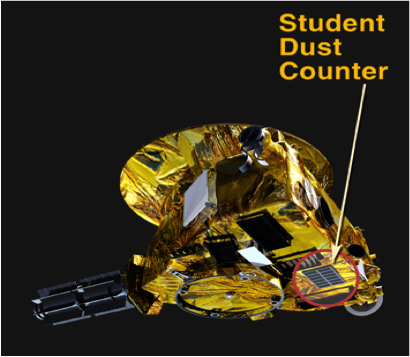Instrument Description
Designed and built by students at the University of Colorado at Boulder, SDC is the first science instrument on a NASA planetary mission to be designed, built and "flown" by students. The instrument includes two major pieces: an 18-by-12-inch detector assembly, which is mounted on the outside of the spacecraft and exposed to the dust particles; and an electronics box inside the spacecraft that, when a hit occurs on the detector, deciphers the data and determines the mass and speed of the particle. Because no dust detector has ever flown beyond 18 astronomical units from the Sun (nearly 1.7 billion miles, about the distance from Uranus to the Sun), SDC data is giving scientists an unprecedented look at the sources and transport of dust in the solar system.
Scientific Objectives
The Student Dust Counter has 3 main goals.
The SDC data are housed at the PDS/SBN node
Useful Mission Documents
Also See Space Sci Rev (2008) 140: 387–402, DOI 10.1007/s11214-007-9250-y, M. Horanyi, The Student Dust Counter on the New Horizons Mission.
Designed and built by students at the University of Colorado at Boulder, SDC is the first science instrument on a NASA planetary mission to be designed, built and "flown" by students. The instrument includes two major pieces: an 18-by-12-inch detector assembly, which is mounted on the outside of the spacecraft and exposed to the dust particles; and an electronics box inside the spacecraft that, when a hit occurs on the detector, deciphers the data and determines the mass and speed of the particle. Because no dust detector has ever flown beyond 18 astronomical units from the Sun (nearly 1.7 billion miles, about the distance from Uranus to the Sun), SDC data is giving scientists an unprecedented look at the sources and transport of dust in the solar system.
Scientific Objectives
The Student Dust Counter has 3 main goals.
- To map the dust density distribution in the solar system, getting an accurate map of how this dust density varies.
- To understand the dust particle size distribution and how it varies throughout the Solar System.
- To determine how fast the Kuiper Belt produces dust.
The SDC data are housed at the PDS/SBN node
Useful Mission Documents
The Archive Collection - The data span the period 2007-01-01 to 2007-06-27
Note: For the Jupiter encounter mission phase, SDC collected no science data during the Jupiter flyby, as the requisite spacecraft configuration prevented SDC from operating. There were some very sparse data taken from December, 2006 through April, 2007, and some of very short (or zero) duration after the Jupiter flyby from April, 2007 through June, 2007.
Publications - A listing of team members to facilitate literature searches.
Note: For the Jupiter encounter mission phase, SDC collected no science data during the Jupiter flyby, as the requisite spacecraft configuration prevented SDC from operating. There were some very sparse data taken from December, 2006 through April, 2007, and some of very short (or zero) duration after the Jupiter flyby from April, 2007 through June, 2007.
Raw Data
Citation to use when referencing this data set: "Horanyi, M., NEW HORIZONS SDC JUPITER ENCOUNTER V2.0, NH-J-SDC-2-JUPITER-V2.0, NASA Planetary Data System, 2007.”
Calibrated Data
Citation to use when referencing this data set: "Horanyi, M., NEW HORIZONS SDC JUPITER ENCOUNTER V2.0, NH-J-SDC-3-JUPITER-V2.0, NASA Planetary Data System, 2007.”
Citation to use when referencing this data set: "Horanyi, M., NEW HORIZONS SDC JUPITER ENCOUNTER V2.0, NH-J-SDC-2-JUPITER-V2.0, NASA Planetary Data System, 2007.”
Calibrated Data
Citation to use when referencing this data set: "Horanyi, M., NEW HORIZONS SDC JUPITER ENCOUNTER V2.0, NH-J-SDC-3-JUPITER-V2.0, NASA Planetary Data System, 2007.”
Publications - A listing of team members to facilitate literature searches.

 PDS: The Planetary Atmospheres Node
PDS: The Planetary Atmospheres Node


